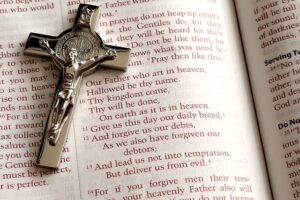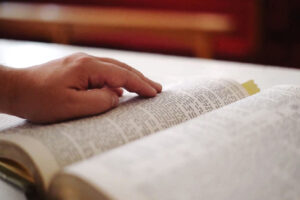Last edited on 25/Jul/2020
Bible Study: Mark Chapter 2 (English Standard Version)
Jesus Heals a Paralytic (Mark 2:1–12)
1 And when he returned to Capernaum after some days, it was reported that he was at home. 2 And many were gathered together, so that there was no more room, not even at the door. And he was preaching the word to them. 3 And they came, bringing to him a paralytic carried by four men. 4 And when they could not get near him because of the crowd, they removed the roof above him, and when they had made an opening, they let down the bed on which the paralytic lay. 5 And when Jesus saw their faith, he said to the paralytic, “Son, your sins are forgiven.” 6 Now some of the scribes were sitting there, questioning in their hearts, 7 “Why does this man speak like that? He is blaspheming! Who can forgive sins but God alone?” 8 And immediately Jesus, perceiving in his spirit that they thus questioned within themselves, said to them, “Why do you question these things in your hearts? 9 Which is easier, to say to the paralytic, ‘Your sins are forgiven’, or to say, ‘Rise, take up your bed and walk’? 10 But that you may know that the Son of Man has authority on earth to forgive sins”—he said to the paralytic— 11 “I say to you, rise, pick up your bed, and go home.” 12 And he rose and immediately picked up his bed and went out before them all, so that they were all amazed and glorified God, saying, “We never saw anything like this!”
Commentary
Now Jesus returns to Capernaum, which was where he cast out the demon in the synagogue and healed Simon Peter’s mother-in-law, after preaching and healing people in desolate places (Mark 1:45). Jesus is preaching the Word of God to a huge crowd, and in the meantime four men carrying a paralytic are so desperate to see Jesus, that they let him down through the roof. Following this, Jesus did something amazing—he forgave the paralytic of his sins. This is amazing because only God can forgive sins; Jesus was claiming deity. This is why the people thought that Jesus was blaspheming, because they were in error and did not believe he was God in flesh.
Using his divine omniscience, also something which only God can have, Jesus knew what they were thinking (verse 8; see also John 21:17), and challenged them. He asked them why they questioned him in their hearts, and posed them a rhetorical question: “Which is easier, to say to the paralytic, ‘Your sins are forgiven’, or to say, ‘Rise, take up your bed and walk’? Obviously it is easier to say “Your sins are forgiven”, because it is impossible to verify such a claim, but a pronouncement of healing can be. Then, to prove that he has the authority to forgive sins (verse 10) with a verifiable claim, he said to the paralytic: “I say to you, rise, pick up your bed, and go home.” Immediately, the paralytic was healed and walked home, and the people were amazed because they had never seen anything happen like that.¹
Jesus called himself the Son of Man and said that the Son of Man has authority to forgive sins. This is his most common title for himself, and it is only used by Jesus. In Daniel 7:13–14, the Son of Man is someone whom, in the last days, God the Father has given absolute authority, divine glory, and sovereign power, and this is what Jesus refers to whenever he calls himself by this title.¹ What makes it clear, is the fact that he associated his title with the authority to forgive sins in verse 7, and the power of judgement and salvation in chapters 8:38 and 13:26–27.¹ Later on the Jewish Council believed this to be a claim to deity in Mark 14:62–64.¹ Clearly then, it was an immense claim to make, one which no one could ever take lightly, especially in a Jewish community, due to its divine connotations.
Jesus Calls Levi (Mark 2:13–17)
13 He went out again beside the sea, and all the crowd was coming to him, and he was teaching them. 14 And as he passed by, he saw Levi the son of Alphaeus sitting at the tax booth, and he said to him, “Follow me.” And he rose and followed him. 15 And as he reclined at table in his house, many tax collectors and sinners were reclining with Jesus and his disciples, for there were many who followed him. 16 And the scribes of the Pharisees, when they saw that he was eating with sinners and tax collectors, said to his disciples, “Why does he eat with tax collectors and sinners?” 17 And when Jesus heard it, he said to them, “Those who are well have no need of a physician, but those who are sick. I came not to call the righteous, but sinners.”
Commentary
In a similar fashion to when he called the first four apostles, here Jesus called Levi (also known as Matthew) the tax collector, and he immediately stopped what he was doing to follow Jesus. Tax collectors were especially hated by the Jews in those times, because they were considered to be traitors who supported Rome and dishonest thieves for their common deception, taking away from the poor all that they have, and making a practice of taking more money than necessary. Therefore, for Jesus to pick a tax collector as one of his apostles is a most interesting choice. It shows that Jesus looks beyond outward appearances and stereotypes to what lies within an individual’s heart. What made it worse, especially for the Pharisees, was that many “tax collectors” and “sinners” were eating with him, which displayed Jesus’ fellowship with them.
The Pharisees were one of the groups within the religious Jewish community of the 1st century AD, and the largest of them all.² They originated from the Babylonian exile, which was the time when studying the Scriptures became very important for the Jews in their worship, because there was no temple for them to make animal sacrifices to God, and they focused on interpreting and applying the Torah (Genesis to Deuteronomy) for everyday life.² In general they were highly religious and devout.²
Understandably, they questioned why Jesus, a holy man, would recline at table with them. They thought that the tax collectors and sinners were to be hated, but Jesus opposed that, and said that instead they were sick and in need of a physician—a Saviour from sin.³ Instead of Christ’s holiness separating him from them, as the Pharisees would think, it was his mission of calling not the righteous but sinners to repentance, that kept him there with them.³ When Jesus said that he “came not to call the righteous”, he was referring to people like the Pharisees, who, although they were devout, they were also proud, and thought that they were already righteous and did not need to repent of their sins.³ Instead, Jesus was sent to call those “sinners” like the tax collectors, who although they were sinful like the rest of humanity, confessed their sins and were glad to receive Jesus’ teachings and repent.³
Jesus is not encouraging the sinful behaviour of the people whom he was eating with, but rather he was trying to show the Pharisees, whom he cared for, that it is better to humble themselves and to repent of their sins before God than to continue living a lie where they think it is not necessary, and believe that they measure up to the standards of God’s law given through Moses, which they will one day be judged by if they fail to uphold all of it (John 5:44–45).
A Question About Fasting (Mark 2:18–22)
18 Now John’s disciples and the Pharisees were fasting. And people came and said to him, “Why do John’s disciples and the disciples of the Pharisees fast, but your disciples do not fast?” 19 And Jesus said to them, “Can the wedding guests fast while the bridegroom is with them? As long as they have the bridegroom with them, they cannot fast. 20 The days will come when the bridegroom is taken away from them, and then they will fast in that day. 21 No one sews a piece of unshrunk cloth on an old garment. If he does, the patch tears away from it, the new from the old, and a worse tear is made. 22 And no one puts new wine into old wineskins. If he does, the wine will burst the skins—and the wine is destroyed, and so are the skins. But new wine is for fresh wineskins.”
Commentary
After John the Baptist’s disciples and the Pharisees noticed that Jesus’ disciples did not fast unlike them, they asked Jesus about this. In his answer, Jesus described himself as the bridegroom, and that his disciples do not fast because marriages are supposed to be times of rejoicing, whereas fasting is usually done during times of mourning or suffering. “When the bridegroom is taken away”, that is, after Jesus’ death on the cross, is when the disciples, and many others, would fast out of sorrow.
Jesus then tells everyone there a parable about garments and wineskins. In this parable, Jesus compares his ministry to new cloths being sewed onto old garments and new wine being poured into old wineskins. The result is that the new patch tears away from the old cloth, creating a worse tear, and the old wineskin bursts, spoiling the wine. In the same way, the gospel that Jesus preached “tears away” and “bursts” the Pharisees’ man-made traditions of fasting and table fellowship,⁴ giving us freedom in how we worship God.
The scribes and Pharisees of the day introduced many unbiblical and man-made traditions to the Jewish community, many of which instead of bringing people closer to God, actually made God’s Word void, or of no value, which Jesus pointed out later in the Gospels (Mark 7:1–13). This was not compatible with what Jesus came to do and teach.
Jesus Is Lord of the Sabbath (Mark 2:23–28)
23 One Sabbath he was going through the cornfields, and as they made their way, his disciples began to pluck ears of corn. 24 And the Pharisees were saying to him, “Look, why are they doing what is not lawful on the Sabbath?” 25 And he said to them, “Have you never read what David did, when he was in need and was hungry, he and those who were with him: 26 how he entered the house of God, in the time of Abiathar the high priest, and ate the bread of the Presence, which it is not lawful for any but the priests to eat, and also gave it to those who were with him?” 27 And he said to them, “The Sabbath was made for man, not man for the Sabbath. 28 So the Son of Man is lord even of the Sabbath.”
Commentary
After some time, on a Sabbath (the seventh holy day of rest), Jesus and his disciples were going through cornfields and the disciples were collecting some food for their journey. However, the Pharisees questioned this activity which seemed unlawful to them, because they were working on a day which God commanded to be a day of rest (Exodus 20:8–11). In order to defend them biblically, Jesus gave them an example of a Scripture, in which king David and his men ate holy bread in God’s temple, while he was running for his life from king Saul, which was meant to be reserved only for the Levitical Priests (1 Samuel 21:1–6). Following this, he said “The Sabbath was made for man, not man for the Sabbath.” In other words, God instituted the Sabbath day for the benefit of humankind, not in order to make the Sabbath just another commandment for people to obey. “So the Son of Man is lord even of the Sabbath.” The purpose in him saying this and referencing the Scripture about David, is to claim that the Lord of the Sabbath, who is Jesus, is greater than David, and that he has divine authority over that day.⁴ If David, who was not the Lord of the Sabbath, could eat holy bread that he wasn’t supposed to eat while on the run, then the Lord of the Sabbath, who has authority and power over that day (which the title “Lord” denotes), can allow his disciples to collect food on a day of rest for his ministry. As the Lord of the Sabbath, Jesus is also the one who established the Sabbath day in the Genesis account of creation, which therefore means that Jesus is God (Genesis 2:1–3).
Next Bible Study
Previous Bible Study
Reference List
1. Hindson, E E, Mitchell, D R (eds) 2010, Zondervan King James Version Commentary: New Testament, Zondervan, Grand Rapids
2. Wenham, D, Walton, S 2001, Exploring the New Testament: A Guide to the Gospels & Acts, IVP Academic, Illinois
3. Henry, M 1708-10, Matthew Henry Bible Commentary, <http://www.christianity.com/bible/commentary.php?com=mh&b=41&c=2>, accessed on 20/02/2017)
4. Engelbrecht, E A, Murray, S R, Paavola, D E, Prange, V H, Sorensen, R A, Walther, M P (eds) 2009, The Lutheran Study Bible, Concordia Publishing House, St. Louis






